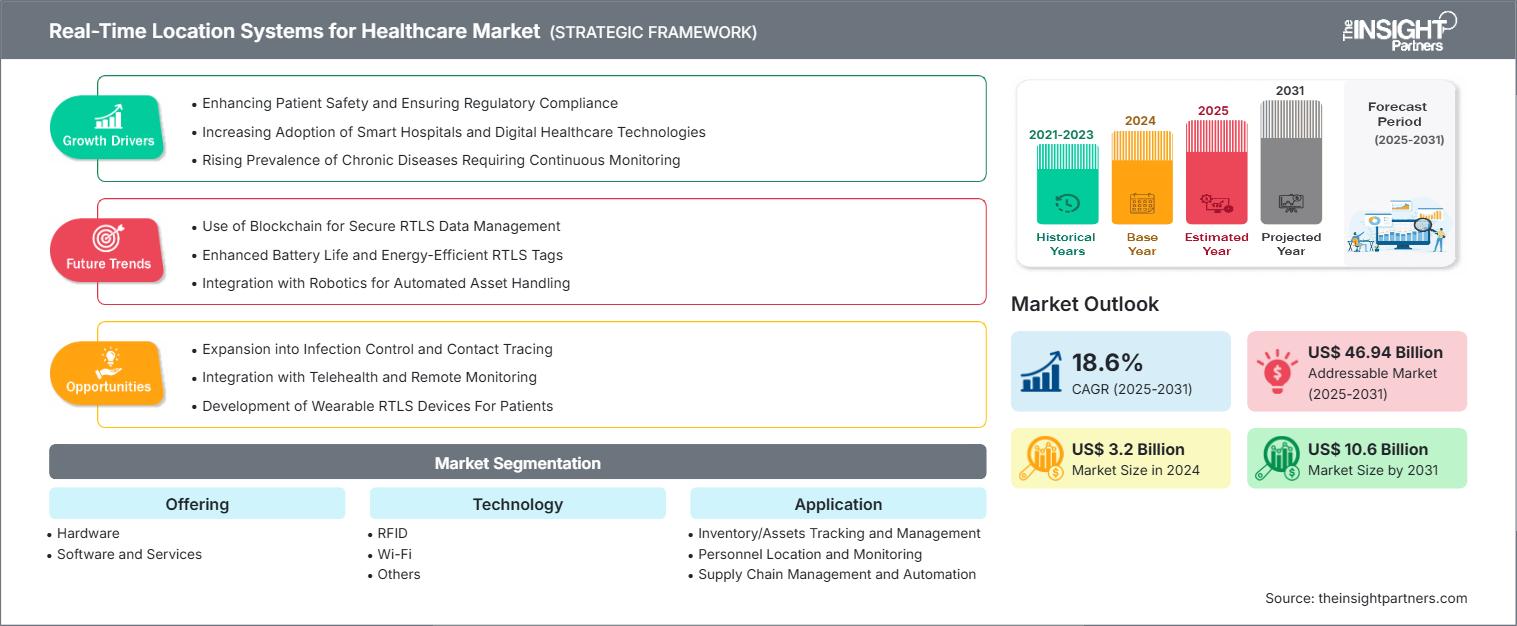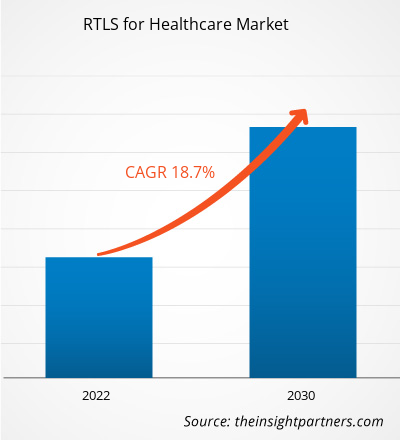의료용 실시간 위치 시스템 시장 규모는 2024년 32억 7천만 달러에서 2031년 106억 6천만 달러로 성장할 것으로 예상됩니다. 이 시장은 2025년부터 2031년까지 18.6%의 CAGR을 기록할 것으로 예상됩니다.
의료 시장 분석을 위한 실시간 위치 시스템
자산 가시성 향상, 환자 안전 강화, 그리고 워크플로우 프로세스 개선에 대한 요구로 인해 의료 분야에서 실시간 위치 시스템 도입이 증가하고 있습니다. 의료 기관 내에서 RTLS는 장비(예: 수술 도구), 직원, 그리고 환자를 추적하는데, 이는 의료 기관이 비용 절감과 환자 치료 개선을 목표로 할 때 중요한 고려 사항입니다. 도입을 촉진하는 또 다른 요인으로는 기술 발전, 특히 IoT, 인공지능 및 기타 기술의 부상이 있습니다.
의료 시장 개요를 위한 실시간 위치 시스템
RTLS는 의료 또는 건강 관련 환경(병원, 외래 진료소, 검사실, 노인 요양 시설 등)에서 사람, 자산 및 환경 조건을 지속적으로 자동 추적할 수 있는 기술과 시스템을 포함합니다. RTLS 시장 성장은 효율적인 환자 관리에 대한 수요 증가, 의료비 절감 필요성, 그리고 환자와 직원 안전에 대한 관심 증가에 힘입어 가속화되고 있습니다.
이 보고서의 일부 또는 국가 수준 분석, Excel 데이터 팩을 포함하여 모든 보고서에 대한 사용자 정의를 무료로 받을 수 있으며, 스타트업 및 대학을 위한 훌륭한 혜택과 할인도 이용할 수 있습니다.
의료 시장을 위한 실시간 위치 시스템: 전략적 통찰력

-
이 보고서의 주요 시장 동향을 알아보세요.이 무료 샘플에는 시장 동향부터 추정치 및 예측까지 다양한 데이터 분석이 포함됩니다.
의료 시장 동인 및 기회를 위한 실시간 위치 시스템
시장 동인:
- 환자 안전 강화 및 규정 준수 보장: 실시간 위치 시스템은 무선 센서와 추적 시스템을 활용합니다. 이를 통해 의료 기관은 환자, 직원 및 장비의 실시간 위치를 추적하여 운영 효율성과 안전 기준을 개선할 수 있습니다. RTLS(실시간 위치 추적 시스템) 규정 준수를 통해 의료 장비, 약물 및 인력의 실시간 위치 및 상태(어둠 상태 포함)를 추적할 수 있습니다.
- 스마트 병원 및 디지털 헬스케어 기술 도입 증가: 스마트 병원과 디지털 헬스케어 기술을 도입하면 의료 시설의 환자 관리, 운영 효율성, 그리고 자산 관리가 혁신됩니다. 스마트 병원은 사물 인터넷(IoT) 기술을 활용하여 병원 내외부에서 직원, 환자, 기기 및 장비를 실시간으로 추적합니다.
- 자산 추적에 대한 수요 증가 의료와 같은 비즈니스 분야에서는 자산 가시성이 필수적입니다. RTLS는 정확한 위치 데이터를 제공하여 자산 손실을 줄이고, 자산 활용도를 높이며, 가동 중단 시간을 줄여줍니다.
- 워크플로우 최적화에 대한 수요 증가 RTLS는 인력 및 장비의 이동을 추적하여 조직의 워크플로우를 최적화하는 데 도움을 줍니다. 실시간 가시성을 확보하면 병목 현상을 제거하고, 반품 시간을 단축하며, 생산성을 높일 수 있습니다. 린 시스템을 개선하려는 조직에게 RTLS는 핵심 요소가 될 수 있습니다.
시장 기회:
- 감염 관리 및 접촉자 추적으로의 확장: RTLS는 운영 효율성을 높이고 환자 안전을 강화하지만, 감염 예방에 적용하면 의료 서비스 제공 방식이 변화할 수 있습니다. 병원은 감염 관리 조치와 함께 RTLS 기술을 활용하여 잠재적 오염 위치를 파악하고, 노출 사례를 파악하며, 격리 조치를 놀라울 정도로 신속하게 관리할 수 있습니다.
- 노인 및 장기요양 시설에서의 활용 인구 고령화로 인해 더욱 안전한 요양원과 생활 지원 시설에 대한 필요성이 커지고 있습니다. RTLS는 환자 이동을 추적하고, 낙상을 예방하며, 직원에게 실시간으로 알림을 제공하여 노인 돌봄 관리에 유용한 솔루션을 제공합니다.
- 감염 관리에 대한 집중 강화 팬데믹 이후 의료는 감염 관리를 최우선으로 생각합니다. 이 기술은 접촉자 추적, 병실 청소, 사회적 거리두기 준수를 지원하기 위해 상호작용과 이동 경로를 추적하는 데 사용되며, 발병 시 감염 사례 관리를 위한 새로운 모델로 자리매김하고 있습니다.
- 맞춤형 및 확장 가능한 솔루션 RTLS 시스템은 점점 더 모듈화되고 유연하게 설계되어, 공급업체가 소규모로 시작하여 기술에 익숙해짐에 따라 확장할 수 있도록 지원합니다. 이러한 유연성 덕분에 소규모 병원과 진료소의 구축 가능성이 높아지고 잠재 고객 기반이 확대됩니다.
의료 시장 보고서 세분화 분석을 위한 실시간 위치 시스템
의료용 실시간 위치 시스템 시장은 구조, 성장 전망, 그리고 새로운 트렌드를 파악하기 위해 여러 부문으로 분류됩니다. 업계 보고서에 사용되는 표준 세분화 방식은 다음과 같습니다.
제공함으로써:
- 하드웨어: 하드웨어 부문은 태그, 배지, 비콘, 판독기, 센서, 게이트웨이와 같은 기본적인 물리적 요소로 구성됩니다. 이러한 요소들은 의료 시설 내 자산, 직원, 환자를 실시간으로 추적하는 인프라를 구성합니다.
- 소프트웨어 및 서비스: 이 부문은 데이터 시각화, 분석, 시스템 통합을 제공하는 소프트웨어 플랫폼과 설치, 컨설팅, 유지관리, 교육과 같은 서비스로 구성되며, 점점 더 많은 의료 시설에서 RTLS를 도입하여 자산, 직원, 환자를 실시간으로 추적하고 있습니다.
기술별:
- RFID: RFID(무선 주파수 식별) 기술은 의료 분야에서 RTLS의 초석으로, 자산, 직원, 환자를 정확하고 비용 효율적으로 추적합니다.
- Wi-Fi: Wi-Fi RTLS는 의료 환경에서 무선 인프라를 사용하여 자산, 직원, 환자를 실시간으로 찾아 모니터링합니다.
- 기타: "기타" 부문은 적외선(IR), 초음파, 블루투스 저에너지(BLE), 초광대역(UWB)과 같은 새로운 하이브리드 솔루션으로 구성되며, 각각은 응용 분야와 필요한 정밀도 수준에 따라 고유한 장점을 가지고 있습니다.
신청별:
- 재고/자산 추적 및 관리
- 인사 위치 및 모니터링
- 공급망 관리 및 자동화
- 기타
시설 유형별:
- 병원 및 의료
- 시설 노인 생활 시설
지리별:
- 북아메리카
- 유럽
- 아시아 태평양
- 남미 및 중미
- 중동 및 아프리카
의료 시장 지역 통찰력을 위한 실시간 위치 시스템
The Insight Partners의 분석가들은 예측 기간 동안 의료용 실시간 위치 시스템 시장에 영향을 미치는 지역별 동향과 요인을 면밀히 분석했습니다. 이 섹션에서는 북미, 유럽, 아시아 태평양, 중동 및 아프리카, 그리고 중남미 지역의 의료용 실시간 위치 시스템 시장 부문 및 지역별 현황도 살펴봅니다.
의료 시장 보고서 범위를 위한 실시간 위치 시스템
| 보고서 속성 | 세부 |
|---|---|
| 2024년 시장 규모 | 32억 달러 |
| 2031년까지 시장 규모 | 106억 달러 |
| 글로벌 CAGR(2025~2031년) | 18.6% |
| 역사적 데이터 | 2021-2023 |
| 예측 기간 | 2025-2031 |
| 다루는 세그먼트 |
제공함으로써
|
| 포함된 지역 및 국가 |
북아메리카
|
| 시장 선도 기업 및 주요 회사 프로필 |
|
의료 시장 참여자를 위한 실시간 위치 시스템 밀도: 비즈니스 역학에 미치는 영향 이해
의료용 실시간 위치 시스템 시장은 소비자 선호도 변화, 기술 발전, 그리고 제품 이점에 대한 인식 제고 등의 요인으로 인한 최종 사용자 수요 증가에 힘입어 빠르게 성장하고 있습니다. 수요 증가에 따라 기업들은 제품 및 서비스 확장, 소비자 니즈 충족을 위한 혁신, 그리고 새로운 트렌드를 적극 활용하며 시장 성장을 더욱 가속화하고 있습니다.

- 헬스케어 시장을 위한 실시간 위치 시스템 주요 업체 개요를 확인하세요.
지역별 의료 시장 점유율 분석을 위한 실시간 위치 시스템
아시아 태평양 지역의 의료용 실시간 위치 시스템 시장은 의료 투자 증가, 기술 발전, 그리고 신흥 경제권 전반의 효율적인 환자 관리, 자산 추적 및 병원 워크플로우 최적화에 대한 수요 증가로 가장 빠른 성장을 보이고 있습니다. 중남미, 중동 및 아프리카 신흥 시장은 의료 서비스 제공업체를 위한 실시간 위치 시스템 시장이 확장될 수 있는 미개척 기회를 보유하고 있습니다.
의료 시장 성장을 위한 실시간 위치 시스템은 의료 인프라, 기술 도입 및 투자 수준의 차이로 인해 지역마다 다릅니다. 아래는 지역별 시장 점유율 및 추세를 요약한 것입니다.
1. 북미
- 시장 점유율: 글로벌 시장의 상당 부분을 차지합니다.
-
주요 동인:
- 선진 의료 인프라
- 북미의 첨단 의료 인프라는 기존 디지털 시스템과의 통합을 가능하게 하여 RTLS 도입을 지원하고, 의료 시설 전반에서 환자 치료, 자산 관리, 운영 효율성을 개선합니다.
- 원격 진료 및 웨어러블 기술의 높은 채택률
- 디지털 건강에 대한 강력한 정부 및 보험 지원.
- 추세: 가치 기반 치료와 통합 원격 모니터링 시스템으로의 전환.
2. 유럽
- 시장 점유율: EU의 엄격한 조기 규제로 인해 상당한 점유율 확보
-
주요 동인:
- 환자 안전과 병원 효율성에 중점을 둡니다.
- 환자 안전과 병원 효율성에 중점을 두면서 RTLS 도입이 촉진되어 실시간 모니터링이 가능해지고, 오류가 줄어들고, 워크플로가 개선되고, 의료 시설 내에서 리소스 활용도가 향상됩니다.
- 스마트 헬스케어 솔루션에 대한 규제 지원
- 인구 고령화로 인해 환자 모니터링과 자산 추적을 개선해야 할 필요성이 커지고 있습니다.
- 추세: 스마트 병원의 확장과 RTLS와 EHR 시스템의 통합.
3. 아시아 태평양
- 시장 점유율: 지배적인 시장 점유율을 가진 가장 빠르게 성장하는 지역
-
주요 동인:
- 의료 인프라의 급속한 확장
- 의료 인프라가 급속히 확장됨에 따라 새로 건설된 시설에서 효율적인 자산 추적, 환자 모니터링, 워크플로 최적화에 대한 수요가 증가하고 있습니다.
- 디지털 건강 이니셔티브에 대한 정부 투자
- 환자 안전 및 병원 워크플로 최적화에 대한 인식 증가
- 추세: Bluetooth와 Wi-Fi를 활용한 비용 효율적인 RTLS 솔루션 도입.
4. 중동 및 아프리카
- 시장 점유율: 규모는 작지만 빠르게 성장하고 있습니다.
-
주요 동인:
- 국가 디지털 건강 전략(예: 사우디 비전 2030)
- 사우디 비전 2030과 같은 국가 디지털 건강 전략은 디지털 변혁, 통합 EHR 생성, 안전한 건강 정보 시스템 및 워크플로 자동화를 요구합니다.
- 민간 의료 부문의 성장
- 추세: 고급 사립 병원과 정부 지원 시설에서 RTLS가 점진적으로 도입되고 있습니다.
5. 남미 및 중미
- 시장 점유율: 꾸준한 성장으로 시장이 확대되고 있습니다.
-
주요 동인:
- 도시 병원 업그레이드 및 인프라 개발
- 남미와 중미의 도시 병원 업그레이드와 인프라 개발은 시설을 현대화하고 자산, 직원, 환자를 실시간으로 추적하여 치료를 개선하려는 수요를 촉진하여 RTLS 성장을 촉진합니다.
- 브라질과 멕시코의 의료 디지털화 증가
- 민간 의료 서비스 제공업체의 관심 증가.
- 추세: 자산 추적 및 직원 효율성에 초점을 맞춘 시범 프로젝트와 소규모 RTLS 배포.
의료 시장 참여자를 위한 실시간 위치 시스템 밀도: 비즈니스 역학에 미치는 영향 이해
높은 시장 밀도와 경쟁
Zebra Technologies Corp(미국), AiRISTA Flow Inc(미국), Kontakt Micro-Location Sp. Zoo(폴란드), Impinj Inc(미국), GE HealthCare Technologies Inc(미국), Advantech Co Ltd(대만), Siemens AG(독일), Qorvo Inc(미국), CenTrak(미국), Sonitor Technologies AS(노르웨이) 등 주요 글로벌 기업이 존재하기 때문에 경쟁이 치열합니다.
이러한 높은 수준의 경쟁으로 인해 기업은 다음과 같은 서비스를 제공하여 두각을 나타내야 합니다.
- 혁신적이고 안정적인 RTLS 솔루션
- 기존 의료 IT 시스템과의 통합
- 실시간 자산 추적 및 환자 모니터링과 같은 고급 기능
- 강력한 데이터 보안 및 의료 규정 준수
- 다양한 의료 요구를 충족할 수 있는 확장 가능하고 사용자 정의가 가능한 플랫폼입니다.
기회와 전략적 움직임
- AI 및 데이터 분석 통합: 예측 건강 통찰력 및 개인화된 치료 계획을 위한 AI 활용
- 향상된 환자 안전: RTLS를 사용하여 환자 이동을 모니터링하고, 의료 실수를 줄이고, 실시간 알림을 통해 감염을 예방합니다.
연구 과정에서 분석된 다른 회사:
- 스탠리 헬스케어
- 소날레이크 유한회사
- 텔레트래킹 테크놀로지스 주식회사
- 버서스 테크놀로지 주식회사
- 에카하우 주식회사
- 유비센스 그룹 주식회사
- 에어로스카우트
- 스탠리 블랙앤데커 주식회사
- 스탠리 헬스케어 솔루션
- 아스콤 홀딩 AG
- 센트랙
- 쿠파
- 접촉 추적 솔루션
- RTLS 솔루션 주식회사
- 에어 RFID
의료 시장을 위한 실시간 위치 시스템 뉴스 및 최근 개발
- AiRISTA, 차세대 RTLS 플랫폼 Sofia 7.2 출시 발표, 2024년 6월 - AiRISTA는 AI 기반 IoT 환경에 적합한 차세대 RTLS 플랫폼 Sofia 7.2를 출시했습니다. RTLS 공급업체는 실시간 자원 위치 추적 기능을 제공할 수 있습니다. AiRISTA의 Sofia RTLS 플랫폼은 원활한 운영의 핵심인 워크플로우를 지원하는 데 그치지 않습니다. Sofia 7.2 출시를 통해 AiRISTA는 워크플로우 유연성과 통합 기능을 확장했습니다.
- Kontakt.io는 2025년 7월 Staff Safe 직장 폭력 예방 솔루션의 대대적인 확장을 발표했습니다. Kontakt.io는 Staff Safe 직장 폭력 예방 솔루션을 대대적으로 확장하여 실외 전체까지 적용한다고 발표했습니다. 이러한 발전으로 병원은 이제 단일 통합 RTLS 플랫폼을 사용하여 실내는 물론 주차장, 차고, 하차 구역, 보행로 등 캠퍼스 전체에 걸쳐 포괄적인 직원 보호를 제공할 수 있습니다.
의료 시장 보고서 범위 및 제공물을 위한 실시간 위치 시스템
"헬스케어를 위한 실시간 위치 시스템 시장 규모 및 예측(2021~2031)" 보고서는 아래 영역을 포괄하여 시장에 대한 자세한 분석을 제공합니다.
- 범위에 포함된 모든 주요 시장 부문에 대한 글로벌, 지역 및 국가 수준의 의료용 실시간 위치 시스템 시장 규모 및 예측
- 실시간 위치 시스템 시장 동향 및 드라이버, 제약 및 주요 기회와 같은 시장 역학
- 자세한 PEST 및 SWOT 분석
- 주요 시장 동향, 글로벌 및 지역 프레임워크, 주요 참여자, 규정 및 최근 시장 개발을 다루는 의료용 실시간 위치 시스템 시장 분석
- 실시간 위치 시스템(헬스케어 시장)에 대한 시장 집중도, 히트맵 분석, 주요 업체 및 최근 개발 현황을 다루는 산업 환경 및 경쟁 분석
- 자세한 회사 프로필
- 과거 분석(2년), 기준 연도, CAGR을 포함한 예측(7년)
- PEST 및 SWOT 분석
- 시장 규모 가치/거래량 - 글로벌, 지역, 국가
- 산업 및 경쟁 환경
- Excel 데이터세트
최근 보고서
관련 보고서
사용 후기
구매 이유
- 정보에 기반한 의사 결정
- 시장 역학 이해
- 경쟁 분석
- 고객 인사이트
- 시장 예측
- 위험 완화
- 전략 기획
- 투자 타당성 분석
- 신흥 시장 파악
- 마케팅 전략 강화
- 운영 효율성 향상
- 규제 동향에 발맞춰 대응






















 무료 샘플 받기 - 의료 시장을 위한 실시간 위치 시스템
무료 샘플 받기 - 의료 시장을 위한 실시간 위치 시스템